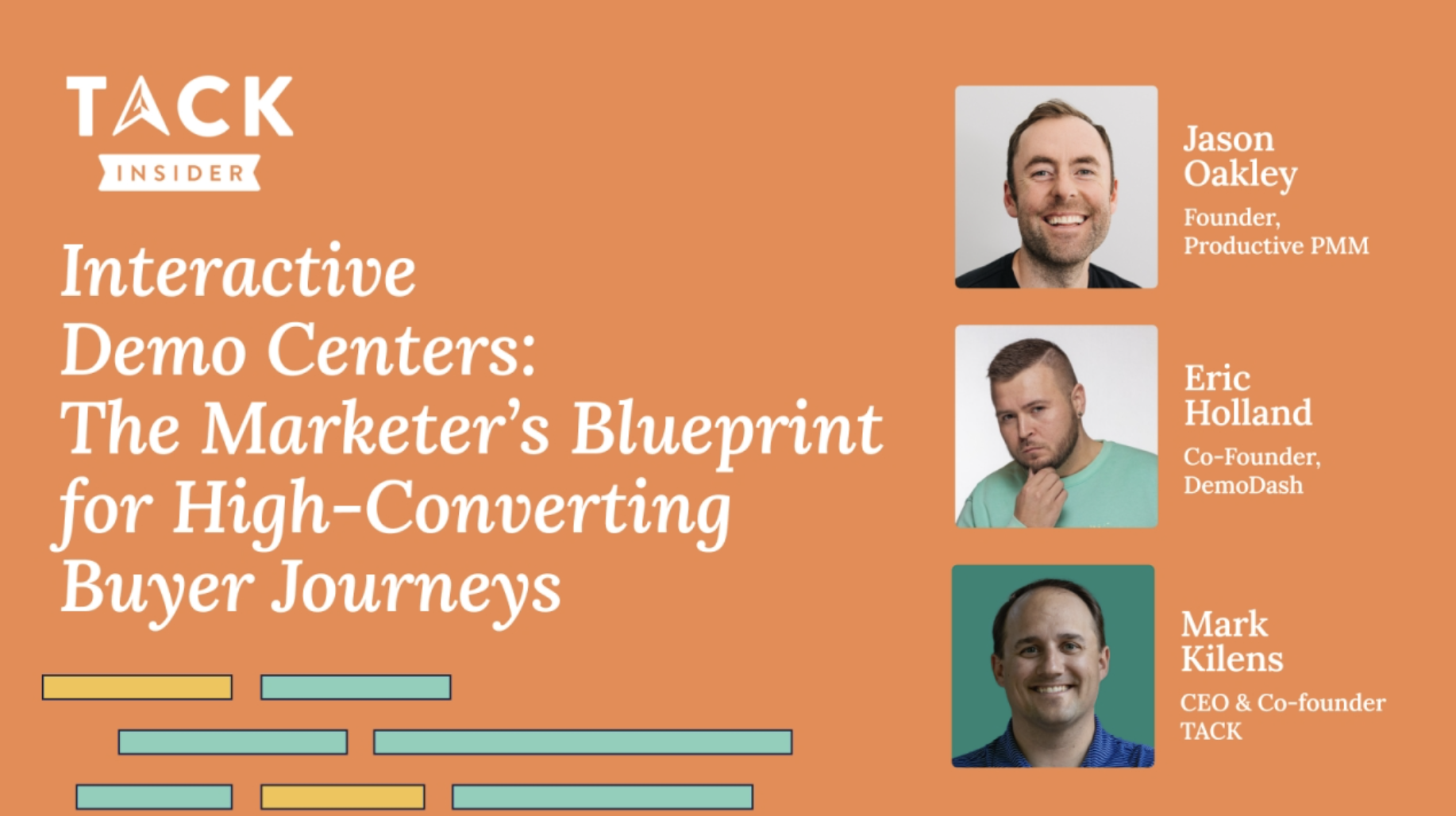Hosted by: Mark Kilens, Co-Founder at TACK
Speakers: Jason and Eric from DemoDash
Overview
Today’s B2B buyers want to test drive—not just window shop. Static feature pages and long sales cycles no longer cut it. Enter the “demo center”: a centralized, use-case-driven hub of interactive demos that gives prospects instant, hands-on exposure to your product, mapped to their needs.
In this edition of TACK Insider, host Mark Kilens sat down with Jason Oakley and Eric Holland—to unpack why demo centers matter, how to structure one, and what actually drives conversions. The pair draw from firsthand experience building and measuring demo centers for fast-growing SaaS brands like Clue, Outreach, and Novatic.
What follows is a practical breakdown—not just of why demo centers work, but how to build one that delivers pipeline, not just page views.
Check out the full slides of the webinar
1. Why Demo Centers Outperform Single Product Tours
Interactive demos are no longer “nice to have”—they’re table stakes. But slapping one generic tour on your homepage won’t cut it. Why? Because most SaaS products serve multiple personas, solve multiple jobs, and have multiple points of entry.
Instead, build a centralized hub—a demo center, that:
- Tailors demos to specific personas, use cases, or pain points.
- Gives buyers the option to explore on their own terms.
- Surfaces value early, without waiting for a sales call.
Eric shared the story of Clue’s “Demo Arena,” which replaced scattered one-size-fits-all tours with a clear persona-based layout. The result? More contextual, relevant experiences—and 600+ companies self-qualified through the center in just four months.
2. How to Plan and Structure Your Demo Center
Before jumping into copy or design, map out the structure like a product marketer would:
Plan cross-functionally:
- Partner with sales to identify the most important personas and use cases.
- Get early executive buy-in—it’s critical for resourcing and velocity.
Structure with clarity:
- Organize by persona (e.g., product marketer, sales ops), use case (e.g., “launch a competitive campaign”), or pain point (e.g., “slow onboarding”).
- Embed 3–6 concise demos on a single page or break them into dedicated landing pages.
- “Demo Center” is functional but forgettable. Go with something memorable—e.g., Demo Arena (Clue), Demo Ranch (User Evidence), or Blueprints (Vitally).
Collaborate across teams:
- Wireframe the flow.
- Loop in design early.
- Integrate with your CRM to capture and attribute interactions.
“Do not call your demo center a demo center. Give it personality so people remember it.”
3. Write Copy That Sells the Story, Not Just the Steps
Interactive demos are not how-to manuals—they’re mini sales conversations. So ditch robotic instructions and write like a human.
Avoid:
- Feature dumps (“You click here, then you click here…”)
- Jumps with no transition
- Long-winded or overly technical explanations
Instead:
- Lead with the buyer’s problem or job to be done
- Anchor around one big insight or reveal
- Use social proof tied to specific features or outcomes
- Keep demos to 10–15 steps max
Examples from Jason and Eric included contextual pain framing (“Triaging urgent intel so you never get blindsided”) and demo openings with personality (“Looks like there’s a call starting—let’s see how this works in Dooly”).
4. Use Smart CTAs to Drive Real Conversions
The best demo centers don’t just show value—they move prospects toward action.
Tactical tips:
- Add CTAs every 5 steps, not just at the end
- Personalize CTA copy (“Seen enough? Talk to Sales” beats “Submit”)
- A/B test button text, placement, and frequency
- Use demo engagement as a trigger for chat outreach or sales follow-up
5. Instrument for Attribution—And Prove Impact
Building a demo center is only half the battle. Measuring and attributing impact is what gets you more budget and internal support.
Measurement playbook:
- Integrate with your CRM (Novatic’s embed events + scripts make this easier)
- Use tools like HubSpot or Clearbit to identify visitors without forms
- Gate only if you can’t capture account-level engagement through other means
- Track metrics like: # of engaged companies, demo completions, demo-sourced pipeline
Clue’s demo arena, for instance, generated over $1 million in influenced pipeline within the first 120 days—without gating.
Key Takeaways
- Don’t rely on one-size-fits-all tours—build a hub tailored to personas and use cases.
- Plan collaboratively, name it creatively, and structure it like a product experience.
- Keep demos short, human, and emotionally resonant—not robotic walkthroughs.
- Distribute and optimize like a conversion asset, not a brochure.
- Measure what matters: engagement, attribution, and actual pipeline.




